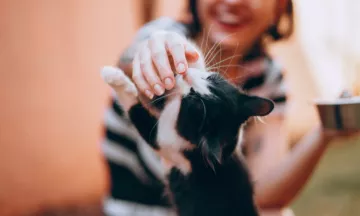There’s more to a cat’s meow than meets the ear. If you are a cat owner or a regular pet sitter, you might recognize sound patterns from your cat with consistent meanings….from hello, to feed me, to please let me out of this cat carrier NOW!

Cats mew as kittens to demand food from their mum, which gradually stops as they are weaned. But as cats depend on us for food (and we humans miss the subtle body language that cats use amongst each other), they have evolved to meow at humans throughout their whole lifetime. Cats generally don’t meow demandingly at each other, except for some chirping between mother cats and kittens, or cats that are close companions.
As any cat person knows, this sweet sound tugs on the heartstrings and often influences the melody of our voices when we chat back to our cats. A high chirpy meow might be a greeting, a drawn-out meow might be a demand for food, a low growling meow might indicate grumpiness or fear and a yowling meow might be a territorial cry.
While there are some common patterns, every cat is an individual – as we cat people already know! Like the human voice, there are many factors that influence why one cat sounds raspy and sounds squeaky. Everything from upbringing, to breed, to environment, to personality can have an impact on your cat’s unique vocal patterns.
Meowing should always be seen in context, so pay attention to what is happening in the room when your cat meows and their meaning will be a lot clearer! For example, a chirp at you is different to the chirp you hear when puss see a bird outside, or a low meow in front of an empty bowl is different to a low meow when an unfamiliar dog comes too close.
Being familiar with your cat’s meow is a really handy skill to have as an owner or regular pet sitter. If your cat suddenly meows in a way that sounds different and alarming, or stops meowing altogether, it could indicate illness or injury. And if your cat has always meowed excessively, it may be because they know this is how to get food or attention (which isn’t so great at 4am!), so try to ignore the times they are noisiest and reward them when they are quieter.
So embrace the meow-lody of your cat’s mew and pay attention – you’ll be fluent in catspeak in no time! And remember, if you need a cat whisperer (or fancy that you have the skills already) head to Pawshake to find or become a pet sitter today.




